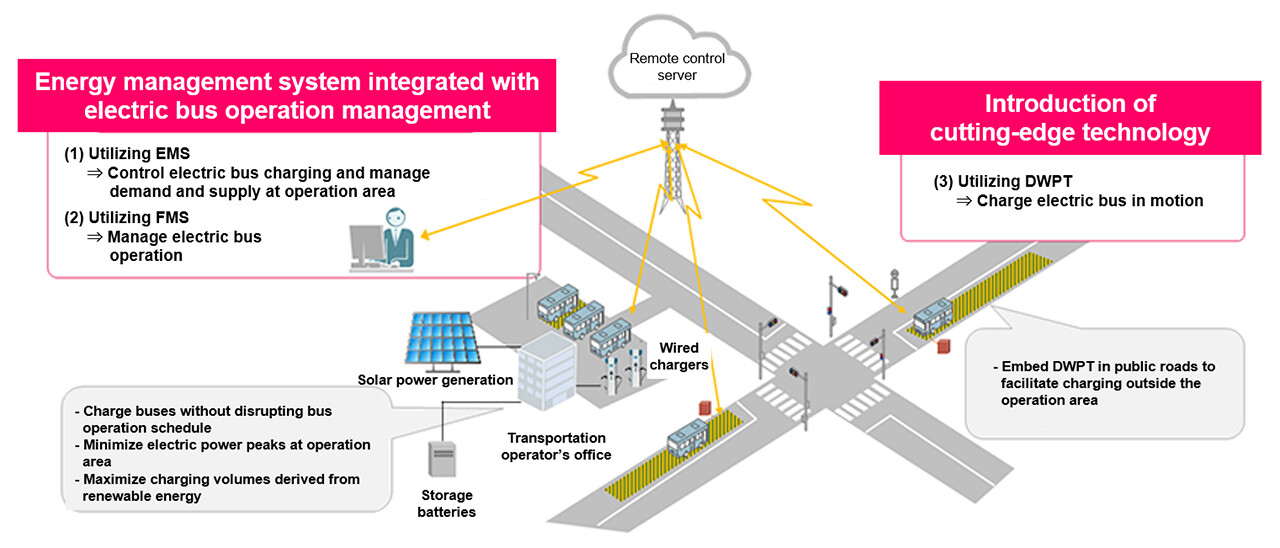Development of an Integrated System for Electric Bus Operation and Energy Management
Managing the operation of 100 electric buses
-
Technologies
Kansai Electric Power Co., Inc.
Osaka Metro Co., Ltd.
Daihen Corporation
Obayashi Corporation
East Nippon Expressway Company Limited
Kansai Electric Power Co., Inc.; Osaka Metro Co., Ltd.; Daihen Corporation; Obayashi Corporation; and East Nippon Expressway Company Limited are selected for the Smart Mobility Society Construction Project operated as part of the Green Innovation Fund promoted by Japan's New Energy and Industrial Technology Development Organization (NEDO). The proposal of five companies' consortium focuses on the development of technologies that integrate electric bus (*1) fleet management and energy management systems (EMS) (*2).
Osaka Metro is set to introduce 100 electric buses from FY2022 onward. The five companies will conduct joint demonstration experiments on managing operations and controlling electric battery charging for the ultimate purpose of operating electric buses inside and outside the Expo 2025 Osaka, Kansai, Japan site. The electric bus operation will then continue in Osaka City after the Expo closes, with ongoing demonstration experiments being conducted through FY2030.
When introducing a large number of electric buses, electrical equipment and power systems in the bus depot have to be strengthened to cope with the overlap in charging times, and there are also concerns over potential increases in electricity costs.
The task of this project is to charge the buses sufficiently to keep them running even in the face of sudden and frequent changes in the operational plan, while also taking into account the timing of charging each bus.
In specific terms, that means achieving optimal energy management by distributing the electricity using hours by developing a fleet management system (FMS) (*3) to manage the operation of the electric buses and an EMS to control battery charging.
The technological development for this project will involve devising an on-road power supply system such as a dynamic wireless power transfer (DWPT) (*4) system for public roads, including high-standard highways (*5), that uses coils embedded in public roads for the purpose of creating an environment that mimics actual usage conditions as closely as possible.
Overview
- Using an EMS and FMS management system that integrates electric bus fleet management and energy management will help create a society that uses energy efficiently. This would be done by leveling the load of electricity usage when transportation companies introduce large numbers of electric buses onto a particular site, and using renewable energy more effectively.
- Cutting-edge technologies such as DWPT will be introduced, and a sustainable smart mobility society for which carbon neutrality is a realistic prospect will be built.
An image of integrated system for electric bus operation and energy management

Details of Development (excerpt)
| (1) EMS Development | (2) FMS Development | (3) DWPT Development |
|---|---|---|
| ・ Charge/discharge planning function capable of managing the introduction of a large number of electric buses ・ Ability to acquire operational plans by linking with FMS ・ Ability to connect with various different charging methods(*6) ・ Ability to make effective use of renewable energy |
・ Operational management that can accommodate on-demand transportation(*7) needs, in which operating routes, boarding and disembarking points, and operating times change depending on passenger requests ・ Ability to acquire information on rechargeable routes (*8) through integration with EMS system |
・ Establishment of methods to reduce equipment costs ・ Increased power, increased speed(*9) ・ Development of equipment that is suitable for public roads, including expressways, etc., and establishment of technology for embedding such equipment into pavement |
Development framework (division of roles within the consortium)

Schedule

The benefits of energy management
- Daily charging is a vital part of any electric vehicle or electric bus operation. With a high-capacity charging system, charging hours will be shorter.
- However, high-capacity charging would mean higher contracted power (due to an increase in the base charge), which inflates electricity bills. Large-scale investment in electrical equipment may be required, and maintenance costs incurred.
- Through energy management, owners can achieve efficient charging and control costs.

- *1 Both fixed-route and on-demand buses are applied
- *2 Energy management system (EMS)
A control system that enables electric buses to be charged efficiently and keeps electricity costs under control - *3 Fleet management system (FMS)
A system for creating and managing operational plans, and arranging the necessary vehicles, etc. - *4 Dynamic wireless power transfer system (DWPT)
A system that uses the principle of electromagnetic induction to wirelessly transmit electricity from coils embedded in the road to coils installed in an electric bus - *5 High-standard highway includes arterial high-standard highways and regional high-standard highways; highways or roads of an equivalent standard that can provide driving services of roughly 60 kilometers per hour or faster
- *6 Includes chargers, rapid chargers, dynamic wireless power transfer (DWPT) systems
- *7 Unlike regular fixed-route buses, on-demand transportation is a public rideshare transportation service operates according to the needs of its passengers
- *8 The ability to obtain information from an EMS on routes where vehicles can be charged through embedded DWPT
- *9 Ability to charge a vehicle via DWPT even when its speed increases

